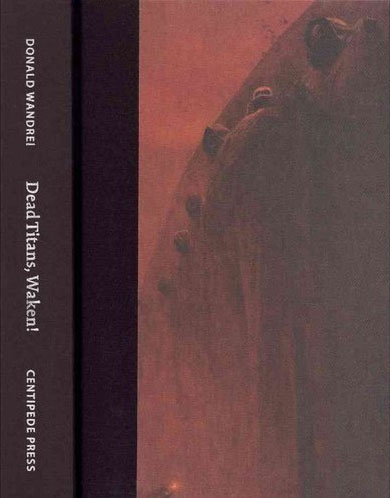
Here's a puzzler: you have Centipede Press, a maker of collectible fantasy and SF books, retailing for $100 and up.
Four of their titles have been reviewed in depth on Amazon by Nguyên, who has written no other reviews except these.
Nguyên clearly isn't the publisher's nephew because the reviews are frank and mostly not too kind: Nguyên complains about typos, image quality, and even the press's choice of authors.
I was planning to write about the book above, containing the two novels written by Donald Wandrei -- a pulp writer of the 1930s, friend and correspondent of H.P. Lovecraft, and co-founder of the publisher Arkham House -- and discovered Nguyên's review, which I mostly agree with. Instead of a review, here are some sticky-notes to Nguyên's takedowns of Wandrei's novels (both written by Wandrei in the early 1930s, when he was in his early 20s):
Dead Titans, Waken! Parts of this resemble Lovecraft's classic tale "The Call of Cthulhu" but it's not fair to call it a knock-off. The first half presents a detective story (I liked these chapters best) centered on the finding of a mysterious green stone in an English cemetery and the calamities it causes, a middle section has a "Cthulhu"-esque news clipping montage describing the increasing agitation of savages and psychopaths the world over as they anticipate the return of monstrous stellar beings to Earth, and then the tone abruptly shifts to a rhapsodic diary where the previously clinical professor-protagonist talks about his deceased wife (for no apparent reason), his dreams, and his eventual sorcerous showdown with those astral Titans on Easter Island. The narrator is then flung 500,000 years into the future into a heavily-populated, urban, barely recognizable Earth, just in time for the Titans to return again.
Invisible Sun. Nguyên nails one problem with this well-written, never-before-published book, which is that its main character (clearly modeled on the author) is very unlikable. For a couple of hundred pages we share the childhood memories and late adolescent thoughts of this brilliant, poetic, obsessive, self-absorbed young jerk who, the first time he falls in love and is rejected, must [SPOILERS} kill the girl and himself, bringing his (and the reader's) agony to a merciful end. The book intriguingly chronicles the bohemian smart set in the US upper midwest during the Jazz Age. F. Scott Fitzgerald's Paris debaucheries have nothing on Wandrei's description of the "pyjama party" that unravels our narrator's life. This is real '60s swinger stuff, taking place in the 1920s. Wandrei's friends in the fantasy community (particularly August Derleth) were so critical of this book that Wandrei permanently shelved it. Structure-wise, it could use some tightening but for present-day readers, it is an intense document of a recluse-in-the-making who didn't kill himself, a man clearly aware of Modern literature but lacking a "circle" that could nurture this kind of writing.
Wandrei wrote Invisible Sun while living in New York City, and he worked for Dutton and other publishers, but he cites as literary inspirations Arthur Machen's The Hill of Dreams and the poetry of fellow fantasist Clark Ashton Smith, as opposed to Hemingway, Faulkner, et al. Wandrei also mentions Swinburne in the book and seems more generally drawn to the Romantic tradition than the strain of factual, existentialist-style writing emerging in the '20s, yet his book has changes of tone and narrative voice as self-conscious as some of Faulkner's experiments. Invisible Sun is modernist in its fragmented, kaleidoscopic style and intermittent use of stream of consciousness but outsider-ish in its lack of participation in a critical tradition where those disjunctions could be understood and evaluated. They seem to be ideas Wandrei plucked out of the air.
We read the fantasy pulps today for their flights of wild poetic description and links to the Gothic tradition and those are Wandrei's strong suits as a writer, with added increments of science-fiction rationalism making the narratives more plausible, a la Lovecraft. A memorable passage in Dead Titans describes a vault deep under that British cemetery where the narrator discovers an enormous heap of human bones. For close to a page, his scientist's eye keeps spotting older and older specimens of skeletons in the pile, and he takes us on a tour of superhuman observation going back hundreds of thousands of years before recorded time into the realms of various ape-like proto-humans, presumably all victims of sacrifice or self-sacrifice. This is a marvelously creepy way to depict ancient evils, dwarfing literate humanity's pitiful, striving seconds on the geological clock.
See also: earlier post on Wandrei and the Lovecraft copyrights.
